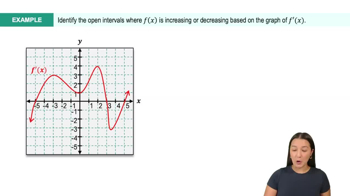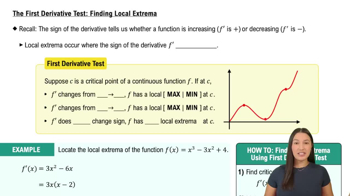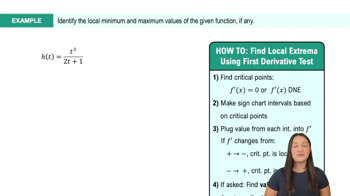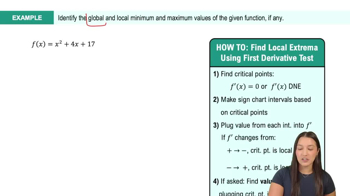Table of contents
- 0. Functions7h 52m
- Introduction to Functions16m
- Piecewise Functions10m
- Properties of Functions9m
- Common Functions1h 8m
- Transformations5m
- Combining Functions27m
- Exponent rules32m
- Exponential Functions28m
- Logarithmic Functions24m
- Properties of Logarithms34m
- Exponential & Logarithmic Equations35m
- Introduction to Trigonometric Functions38m
- Graphs of Trigonometric Functions44m
- Trigonometric Identities47m
- Inverse Trigonometric Functions48m
- 1. Limits and Continuity2h 2m
- 2. Intro to Derivatives1h 33m
- 3. Techniques of Differentiation3h 18m
- 4. Applications of Derivatives2h 38m
- 5. Graphical Applications of Derivatives6h 2m
- 6. Derivatives of Inverse, Exponential, & Logarithmic Functions2h 37m
- 7. Antiderivatives & Indefinite Integrals1h 26m
- 8. Definite Integrals3h 25m
5. Graphical Applications of Derivatives
The First Derivative Test
Problem 52
Textbook Question
First Derivative Test
a. Locate the critical points of f.
b. Use the First Derivative Test to locate the local maximum and minimum values.
c. Identify the absolute maximum and minimum values of the function on the given interval (when they exist).
f(x) = x²/(x² - 1) on [-4,4]
 Verified step by step guidance
Verified step by step guidance1
To locate the critical points of the function f(x) = \frac{x^2}{x^2 - 1}, first find the derivative f'(x) using the quotient rule, which states that if you have a function \frac{u}{v}, then the derivative is \frac{u'v - uv'}{v^2}. Here, u = x^2 and v = x^2 - 1.
Set the derivative f'(x) equal to zero to find the critical points. This involves solving the equation f'(x) = 0, which will give you the x-values where the slope of the tangent line is zero.
Next, determine where the derivative f'(x) is undefined, as these points may also be critical points. This typically occurs when the denominator of the derivative is zero.
Once you have all critical points, use the First Derivative Test. Evaluate the sign of f'(x) on intervals around each critical point to determine whether the function is increasing or decreasing, which will help identify local maxima and minima.
Finally, evaluate the function f(x) at the critical points and at the endpoints of the interval [-4, 4] to find the absolute maximum and minimum values of the function on that interval.
Recommended similar problem, with video answer:
 Verified Solution
Verified SolutionThis video solution was recommended by our tutors as helpful for the problem above
Video duration:
7mPlay a video:
Was this helpful?

 7:32m
7:32mWatch next
Master Determining Where a Function is Increasing & Decreasing with a bite sized video explanation from Callie
Start learningRelated Videos
Related Practice







